I once took a class on first sentences. It was about other things, too, but every week we would recite the first line of our readings to begin discussion. Our evaluative criteria was in constant flux — was it effective, truncated, wrong? The other night, I dreamed I opened a book on Donald Judd and the first sentence read “His boxes are the universe.” In my old class tradition, this dream was more about reviewing first sentences than anything else, so my dream-self commented something along the lines of “Powerful sentence, but I’m not so sure.”
The Chinati Foundation is a sentimental place: I grew up visiting Judd’s aluminum boxes and I turned sixteen inside his concrete works. After moving to the East Coast earlier this year, this visit was my first homecoming. In October I drove to Marfa with my Texas-raised, Philadelphia-living friend M., who is an even more avid proponent of the aluminum boxes than me. Later, in the town’s Crowley Theater, a new friend asked M. if she would explain why she liked the boxes, as word was getting around about her reputation for crying at the sunrise viewings. M. gave a short and eloquent reply, but all that sticks in my head now is her remarking on the way the boxes reflect light.
Roni Horn imagines the desert itself as a mirror, writing “its precise reflections reflect unaltered views to me, reflect unaltered views of me.” It is true that many of the permanent works at Chinati Foundation notoriously reflect, and that even more lend themselves to seeing light straightforwardly: dim, matte reflections of Dan Flavin’s neon on white walls; the rolling sun on Roni Horn’s solid copper Things That Happen Again (1986–88); Robert Irwin’s airy marriage of space and light; and, of course, Donald Judd’s mirrored aluminum boxes.
Alteration, as indicated by Horn, is the principal parameter of reflection, at least insofar as reflection is opposed to refraction. Reflections are the reverting back of light or sound on a plane in the same medium; refractions are the shift in direction of light or sound as they enter a surface and travel from one medium to another. Reflections occur in mirrors; refractions occur in lenses. Reflections are unaltered; refractions are, unequivocally, altered.
By now, Marfa is known for stewarding works that are reflective literally and metaphorically. Since its establishment in 1986, Chinati has been dedicated to preserving what they call a “unique situation, in which artists have determined how their work will be seen in permanent relationship to architecture and the land.” Here objects are fixed in space, enabling visitors to experience continual dialogue between stable forms and a shifting environment. Chinati’s campus is an ongoing experiment in interaction, where seeing between forms is part of knowing them. This emphasis on site and relationality evokes the mirror, an object whose function is predicated on dialogue with external actors. The aluminum boxes reflect the deserts they face, and if the desert is a mirror too (as Horn tells us it is), then Chinati is the plein-air Versailles of the Southwest.
Over dinner a friend introduced the game “Truck or Flower,” which consists of one person choosing an unspoken thing and answering whether the thing in question is more of a truck or a flower. The mystery noun is triangulated through its proximity to either component of the binary, as the group presents half-new, half-old pairs, until the word was caught by way of Comparative Sensibility (truck / mountain; truck / cat; cat / umbrella). Inspired by “Truck or Flower,” this Chinati weekend became about “Reflective or Refraction,” an exercise which is also all about estimation, approximation, and subjective error. In this game, refraction is the foil to the already reflective. Minimalist or otherwise, Marfa is full of obvious reflectives. Refractions are another, less-attended-to tradition.
So far the concept of alteration has been central to my defining reflective and refraction. In Marfa this word is already loaded, mostly in relation to ideas around conservation and preservation. But here, I am referring to the alteration of light, or rather, the alteration of source. Light waves are notably unaltered as they bounce off of mirrors, even if we might think of the reflected image as famously inverted or warped. Refraction is the redirection and transformation of light waves as they pass from one medium to another, the becoming of something else. In language, reflectives are similes and refractors are metaphors. Reflectives direct us to see things through their relating to other things: the aluminum boxes illuminate the desert that illuminates the boxes which illuminate the desert. Refractions are lenses to see things through: green light cast on skin through stained glass, a real or fictive sky through a poem.
My first refraction is Untitled, an undated watercolor by painter-poet Jesse Murry, which I encountered as part of Ballroom Marfa’s exhibition Perhaps the Truth. Set in a small wooden frame, the 11 x 11-inch work on paper bleeds luminous wine and thin vermillion fog. Within the partially torn square, unevenly concentrated clouds of color and annular gestures of pigment are only interrupted by two faint lines at the top and bottom of the page. The discrete lowest line forms the horizon of the work — an intersection of presumed sky and sea that situates the piece within Murry’s larger tradition of landscape painting.
Murry faithfully believed in the emancipatory potential of landscape. Over his lifetime, he indulged in the drama of color and light to paint hundreds of “places summoned by memory and through the imagination.” For Murry, it was in this consumption and subsequent remembrance of real terrains that he was able to find the materia poetica for his imagined ones. Explaining the philosophical ideals behind his painting, he wrote, “the light I came to love in Italy returned in memory as a need to think beyond color toward light as the true emanation of the Spirit,” an ideal which, in practice, “would mean giving an essence to material body like an alchemist.” Returning to the metaphor of refraction, Murry himself was a lens through which light and memory was funneled into a new medium. This new medium was not mimetic, but strove for material essence.
This understanding of refraction — of the body as an altering lens — lends itself most directly to performance, which Chinati has welcomed more of in recent years. For this year’s Chinati Weekend, choreographer Laura Gutierrez and cellist Matt Haimovitz performed on Sarah Crowner’s Platform (Blue Green Terracotta for JC) (2022) for two hours, thoughtfully activating the space in slow, unexpected ways. Two years ago, nine musicians performed a four-hour score by David Dove through the six buildings of Flavin’s untitled (Marfa project) (1996). While composing the score, Dove spent over a week in the Flavin spaces, later remarking that he hoped to accomplish in sound what Flavin accomplished in light. In these performances, which are kind of “in responses to,” we again see sources taken in and redirected.
In her recent essay “Peripatetic Performance and its Histories,” published in Volume 28 of the Chinati Foundation’s newsletter, Ann Reynolds recalls rich traditions of performance and intervention at Chinati (and in Marfa more broadly) that tend to remain “relatively sub-rosa.” First positioning Marfa as a site uniquely primed for performance, Reynolds identifies the medium’s transformative capacity. She writes of works at Chinati by Judd and his contemporaries: “Although almost always abstract and geometric, their work was never about forms per se. It was about arranging, and experiencing the arrangement of, forms in space and in relation over time.” Thus, the insertion of “peripatetic” performance within this orchestra of set relations adds another actor to a fixed stage of reflective surfaces. As much as these performances are a consumption and reinterpretation of that staging, they are also an intervention in it. In terms of metaphor, perhaps this makes them glass.
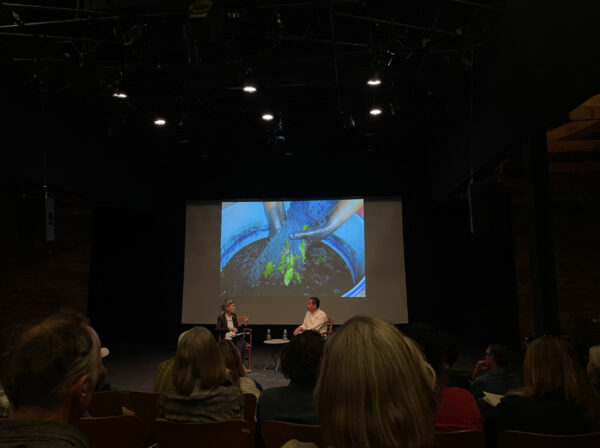
A conversation with Porfirio Gutiérrez and Ingrid Schaffner at the Crowley Theater, October 2023. Photo: Megan Mckenzie.
Returning to refraction, where Murry works from real to imagined landscapes and Dove moves through the Flavins, weaver Porfirio Gutiérrez finds his materia poetica in storytelling. Through his textiles, Gutiérrez incorporates traditional Zapotec designs and processes of natural dying, integrating continuing lineages of making with alternative techniques such as applied embroidery and overdye. During a public lecture on Sunday morning of Chinati Weekend, curator Ingrid Schaffner led the audience through a sampling of Gutierrez’s work, which the artist grounded in anecdotes about himself, his family, and Zapotec culture and community. At the sight of one of his magenta Butterfly weavings, Gutiérrez began, “I was thinking a lot about that movement,” talking about his own migration from Mexico to California, alongside the generational migration of the monarch butterfly.
Gutiérrez never said this weaving was about migration, per se, nor did he position his Cosmos textiles as being about the night sky or celestial bodies. He instead emphasized the presence of these stories in his process, pointing to their physical manifestations by symbol or stitch. As one of my refractors, Gutiérrez embeds ancestral and personal meaning into his weavings, giving material to that which would otherwise remain incorporeal. From Gutiérrez, we know the refracted source need not be physical.
On the Monday after Chinati Weekend, my friends and I spent the afternoon writing poems from the sky and clouds that looked like nail clippings, only to transform into salmon scales in front of our eyes. It’s possible that the sensibility I am trying to call refraction is already named by poetry. It’s also possible that the sensibility I am calling reflective is already minimalist, echoing Stella’s “What you see is what you see.”
Jesse Murry spoke often of angels. He attributes his lasting inclination towards painting to a visit from an angel during his childhood. In 1986 he wrote about angels before the creation of the sun, “perceiving within themselves an image or dim reflection of the creator,” turning to the reality above them, “await[ing] the eternal morning of the vision face to face.” In Islam, angels are believed to have been created by Allah from light, making them another refraction. Marfa has long been a hall of mirrors, and this year there were angels everywhere, too.


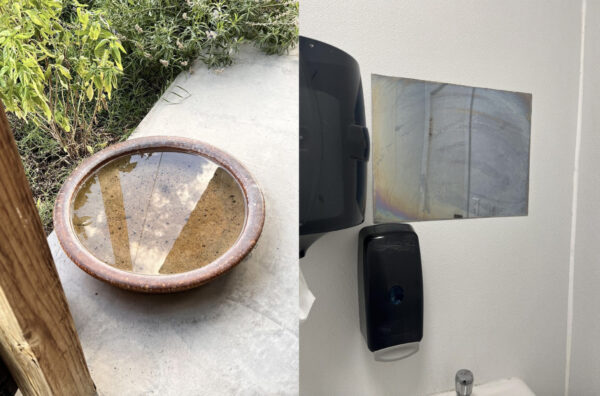
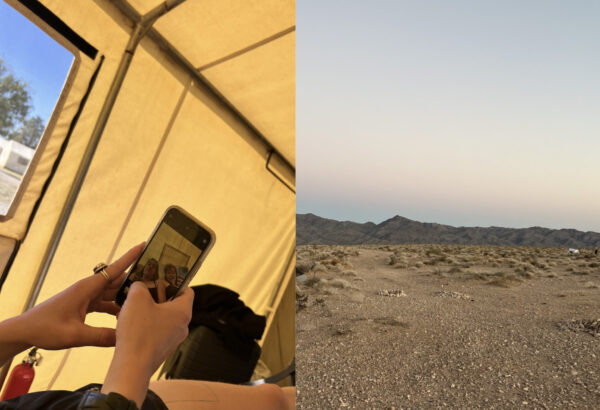


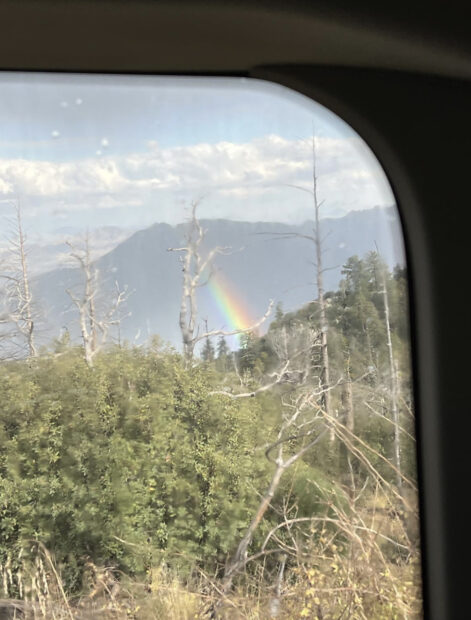
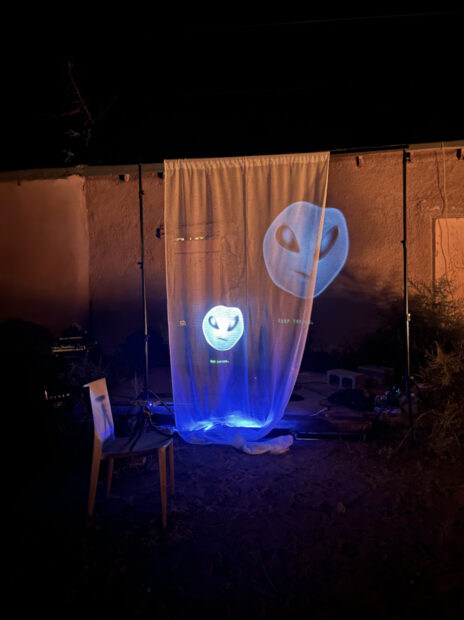

1 comment
You had my attention with the line, I once took a class on first sentences. Although arguably, the title functions as the click bait and Refraction Angels did not disappoint. My other favorite is refraction is the foil to the already reflective. Beautifully written essay. Makes me yearn to return to Marfa.